Antenna Innovations: Keeping Up With The Rest of the Industry?

The latest webinar in the GVF-SEG series begins with this very important question, one based on a very important premise – that the transformation of the commercial exploitation of space and rapid progression from “Space 2.0” to “Space 3.0” (exemplified in such innovations as re-usable and 3-D printed launchers, assembly line satellite manufacturing, terabit-per-second satellite networks) can only be fully realised if comparable innovations occur with antennas.
Antenna innovations in performance, cost, and operation may perhaps be less attention-grabbing than launcher stages softly landing after yet further successful orbiting of multiple satellites, but are no less transformative. Electronically Steered Antennas (ESAs) are just one example of the increased capacity, and even greater future potential, of the satellite terminal to provide vital communications links.
In this discussion, moderated by Jeremy Rose of COMSYS and featuring panellists representing some of the leading voices in the antenna world – Kymeta, INSTER, AvL Technologies, and ANYWAVES – the objective was to inform a global audience as to whether, or not, the antenna industry is keeping pace with other segments of the satellite communications industry.
Discussion began with a request made of the Kymeta representative: To explain the notion of the “disadvantaged antenna”, seemingly a rather novel term – related to the challenges of the technological drive towards small electronically steerable antennas (ESAs) – requiring significant clarification. That clarification was fascinating, prompting a energised following dialogue which, if you missed the live event, you can still enjoy by watching the video the link to which is available here.
Later questions covered differences in the performance and price requirements of high-end ESAs versus those of consumer units; requirements for antennas communicating with NGSO satellite constellations; panellists’ perspectives on the headline-grabbing Starlink antenna; and, what the panellists would like to request of satellite operators to help render more effective and efficient antenna design processes. This was an illuminating dialogue, so don’t miss it,… and miss out.
Q & A continued….
The following question was posed through the chat function during the panel but we ran out of time to respond in the live programme. Thank you to our audience for taking an active part by asking questions, and to our panellists for their time to answer them after the webinar ended… (Please note more questions and answers will appear here as we receive them from the panellists)
1. Richard talks about smaller antennas, so less gain available, so to maintain the link more/higher power PAs are needed. Power/heat has always been an issue with active antennas, so how is this going to be resolved?
Richard Hadsall (Kymeta): The additional power we see would be coming from the Satellite transponder. Where the Small antenna requires more PEB (Power Equivalent Bandwidth) from the satellite then does a parabolic. The ESA heat issue is more commonly found in active Phased Array antennas then in the Passive meta material antennas such as the Kymeta.
2. Hi, I enjoyed your discussion, lots of points I’ve noticed. I need clarification, on this. “Do you know how to testing and calibrating satellite antennas using unmanned aerial systems?”
GVF: GVF has experience with the testing and calibration of satellite antennas using UAS in as much as, in partnership with our member QuadSAT, based in Denmark, we successfully delivered on a joint project which also arose out of the work of the GVF’s Mutual Recognition Arrangement Working Group.
The project, entitled Unmanned Aerial System for Antenna Performance Evaluation (UAS-APE), was conducted under the ESA ARTES (Advanced Research in Telecommunicatons Systems) programme.
QuadSAT is developing a novel approach for conducting on-site antenna verification using UAS, or drones. This has been acknowledged by satellite operators as a valuable alternative to the traditional methods of testing. Use of a transportable airborne platform avoids the need to ship the test antenna to a remote location such as an outdoor far-field antenna range compact range/near-field test facility.
The European Space Agency (ESA) recognised the potential value of this technology and awarded QuadSAT a contract to develop and validate the technology with support from GVF. The Satellite Operators Minimum Antenna Performance (SOMAP) recommendations were used to compare performance data acquired by drone measurements with comparable test data acquired from a traditional far field outdoor test range.
We continue to work with QuadSAT. You may have an interest in reading an article written by QuadSAT‘s CEO, Joakim Espeland.
